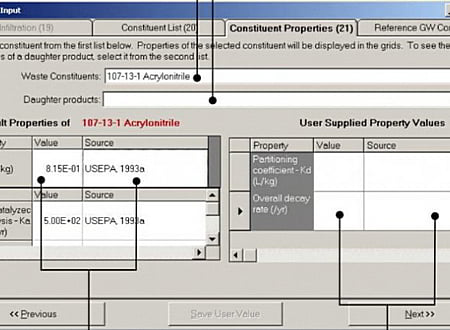The IWEM software is designed to assist you in determining the most appropriate waste management unit design to minimize or avoid adverse ground water impacts, by evaluating types of liners, the hydrogeologic conditions of the site, and the toxicity and expected leachate concentrations of the anticipated waste constituents.
The software helps you compare the ground water protection afforded by various liner systems with the anticipated leachate concentrations, so that you can determine what minimum liner system is needed to be protective of human health and ground water resources (or in the case of land application units (LAUs), determine whether or not land application is recommended).
The anticipated users of the IWEM computer program are managers of proposed or existing units, state regulators, interested private citizens, and community groups.
In an effort to meet the needs of various stakeholders, the guidance for the ground water pathway uses a tiered approach that is based on modeling the fate and transport of waste constituents through subsurface soils and ground water to a well to produce a liner recommendation (or a recommendation concerning land application) that protects human health and the environment. The successive tiers in the analysis incorporate increasing amount of site-specific data to tailor productive management practices to the particular circumstances at the modeled site:
Tier 1: A screening analysis based upon national distribution of data;
Tier 2: A location-adjusted analysis using a limited set of the most sensitive waste- and site-specific data; and
Tier 3: A comprehensive and detailed site assessment.
The IWEM software is designed to support the Tier 1 and Tier 2 analyses. The unique aspect of the IWEM software is that it allows the user to perform Tier 1 and Tier 2 analyses and obtain liner recommendations with minimal data requirements. Users interested in a Tier 3 analysis should consult the Guide for information regarding the selection of an appropriate ground water fate and transport model.
* IWEM download link provides freeware version of the software.
Remediation Evaluation Model for Chlorinated Solvents
REMChlor, or Remediation Evaluation Model for Chlorinated Solvents, is an analytical solution for simulating the transient effects of ground water source and plume remediation.
WATER9, the wastewater treatment model, is a Windows based computer program and consists of analytical expressions for estimating air emissions of individual waste constituents in wastewater collection, storage, treatment, and disposal facilities; a datab
Model Water Distribution Piping Systems
EPANET is software that models water distribution piping systems. EPANET is public domain software that may be freely copied and distributed.
Airport Pavement Design and Evaluation
FAARFIELD, the FAA’s standard software for airport pavement thickness design and evaluation (AC 150/5320-6G, Airport Pavement Design and Evaluation) and pavement strength reporting using the ACR/PCR method.
Fire Calculation for Industrial Halls
LUCA calculates displacements and additional horizontal forces that appear in industrial halls during fire enabling the engineers to consider their effect in the design in order to avoid collapse or risk of human life.
Submit a review about IWEM software with your social media profile







No comments yet. Be the first to comment.